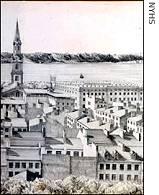2006年VOA标准英语-New York Remembers Its Past Ties to Slavery
搜索关注在线英语听力室公众号:tingroom,领取免费英语资料大礼包。
(单词翻译)
By Amanda Cassandra
New York
30 November 2006
New York is widely regarded as a culturally diverse city that is bastion of tolerance1. But some may be surprised to find out how different the city was in its early years. A new exhibit re-examines New York's role in slavery. From VOA's New York Bureau, correspondent Barbara Schoetzau has the story by Amanda Cassandra.
 |
| New York City in the first half of the 19th century |
"New York Divided: Slavery and the Civil War" is the final installment2 of a year long series on slavery at the New York Historical Society, chronicling the years 1815 through the end of the Civil War in 1865.
The exhibit's chief historian, James Horton, says the importance of slaves to the economies of the northern and southern states is often understated.
"One of the things that you'll see in this exhibit is slavery was central to American life," said James Horton. "It had a central place of importance in American economics. Slavery, by the time of the Antebellum period, decades before the Civil War, slave labor3 produced American cotton. And American cotton was the cornerstone of much of America's economy. The value of cotton exported by this nation was greater than everything else exported by this nation combined."
Bundles of raw cotton dangling4 from the ceiling help visitors visualize5 the lure6 of this commodity.
Southern cotton grown by slaves eventually made up more than 60 percent of all U.S. exports to Europe. The majority of shipments passed through New York ports with New York merchants earning 38 cents of every dollar earned on cotton.
Horton says the array of original documents and objects featured in the exhibit shows New York had a dual7 identity as both the center of the anti-slavery movement and as a major financial backer of slavery because of its commercial ties to the southern slave-holding states.
"This is a story about New York, but because New York is so important in the nation itself, It is a story about the nation and the nation's development," he said. "It is a story that starts with the great American contradiction. Think about this contradiction, 'We hold these truths to be self-evident that all men are created equal, endowed by their creator with certain inalienable rights.' What are they? Life, liberty and the pursuit of happiness and as we say those words, we tolerate the institution of slavery. That's the great American contradiction and you can see that contradiction at work in this great American city."
The exhibition tells visitors that in almost every U.S. presidential election from 1832 to 1868, New Yorkers overwhelming voted for Democratic candidates, who were pro-slavery.
Historical Society president Louise Mirrer says the exhibit shatters the liberal image of New York.
"There were two main trends in New York early and mid-19th century," said Louise Mirrer. "One of them certainly is what we would recognize as today as New York's liberalism and that is the growth and development of the abolitionist movement. It was located on Nassau Street in lower Manhattan. It really took hold and really was quite central to the nation's abolitionist movement. So that looks familiar. What does not look familiar and what really calls into question the liberal tradition of New York and how New Yorkers tend to see themselves, is the fact that New York never voted for [Abraham] Lincoln. Many New Yorkers felt very conflicted on the question of abolishing slavery."
Cotton was such a major boon8 to New York's economy that in 1861 mayor Fernando Wood proposed that the city declare independence from both the north and the south, in order to preserve its role as a major port for both regions.
Christopher Moore from the Schomburg Center for Research in Black Culture is a historian and collaborator9 on the exhibit. He says the conflicting attitudes of the past explored in the exhibit affect race relations in the United States today.
"We have attitudes about one another, blacks and whites," noted10 Christopher Moore. "Those attitudes are forming at this time, in the 19th century. This did not begin to happen recently. This exhibition points out Jim Crow, which affected11 African-Americans throughout the United States with legalized segregation12 in education and housing opportunities, it starts during the slave era."
The tension between commerce and conscience in New York is revealed through historic documents, interactive13 displays and reenactments addressing both sides in the debate over slavery.
Visitors can also learn about some remarkable14 black New Yorkers of the 19th century like James McCune Smith, who was the first black doctor and political candidate in New York State. Another notable New Yorker, Elizabeth Jennings, is described in the exhibit as the "Rosa Parks of the 19th century." After she refused to leave a railway car reserved for whites only, she sued the railway company and won.
Though almost a century and a half has passed since the American civil war, the issue of slavery remains15 an important topic in the United States, and goal of the New York exhibit is to shed more light on one of the most tragic16 periods of American history.
 收听单词发音
收听单词发音 




